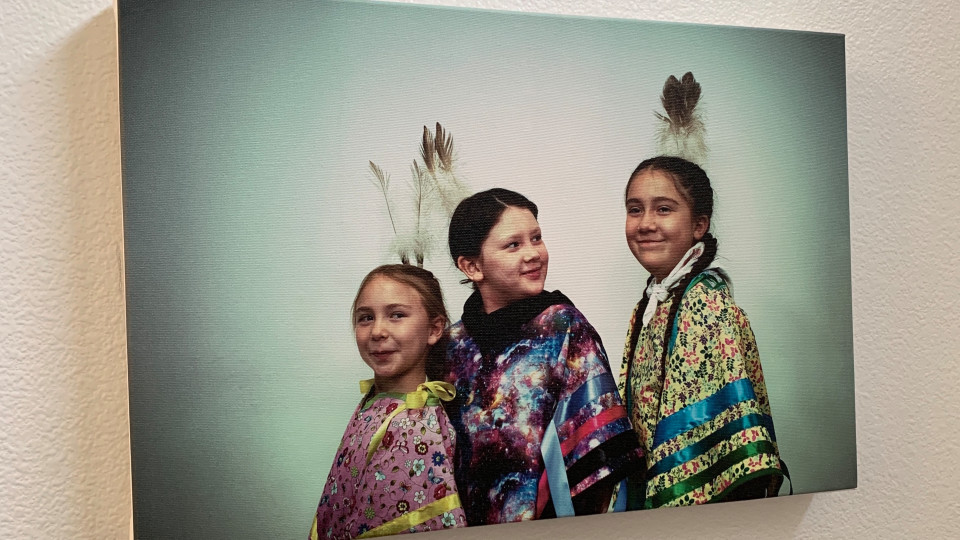To celebrate the online release of the video recordings from last year's AH'-WAH-NEE symposium, we're publishing this piece about the opening day of Fawn Douglas' MFA thesis exhibition written by our colleague Lauren Dominguez. Douglas was the curator and organizer of the AH'-WAH-NEE project.
On April 22, 2022, Fawn Douglas, an MFA candidate from UNLV, opened her thesis show, SOOV, at Nuwu Art Gallery + Community Center in Las Vegas. Nuwu Art Gallery is a POC-owned space that aims to promote, maintain, and revive the cultural traditions of multiple communities of color.
Founded by Douglas and supported by a team of activists known as “the Core,” Nuwu has grown significantly since a series of soft openings in December 2020. The community center has partnered with multiple non-profit organizations such as IndigenousAF and Indigenous Educators Empowerment. SOOV was the first exhibition that invited the public into the space.
Soov is the Southern Paiute word for “willow” or “sumac.” In the exhibition announcement, Douglas wrote, “It [soov] is a word that represents me: strength, creativity and a builder of things that will last.” This show exemplified all of these traits.
As I walked into the gallery, the sun shone brightly through the windows, high along the walls. This was the only source of light for the building. Nuwu was still under construction. Douglas and her partner A.B. Wilkinson joked that the exposed wires snaking out from the ceiling were not live and should be harmless.
The building Nuwu now calls home was once a Jewish place of worship. During the artist's opening remarks she told us that the previous worshipers still came to pray at the door. Once it had been bought by her activist collective, they began to restore the historic structure to make it a home for community members and art makers alike.
The former synagogue still bears signs of its previous life. She pointed out old tiles that had been salvaged and placed into an alcove to serve as a source of spiritual energy for the space.
After her introduction, an Indigenous elder led a prayer to bless the building, the artist, and those who enter the gallery to seek art and community. The late afternoon sun shone through the smoke from the ceremony as it danced in the air.
At the prayer’s conclusion, the gathered crowd dispersed as some turned to admire the artwork, and others began to converse with friends and community members.
Along the north wall resided three vessels made from coils of metal conduit that had been salvaged during the renovations. Douglas described this method of material sourcing as being similar to her ancestors' tradition of foraging for willow to create their woven vessels. It was a somber reminder of the urbanization of this sacred land, but also a testament to the determination of Indigenous peoples to preserve their cultural heritage.
On the south wall hung three printed canvases depicting three young girls dressed in traditional regalia, or “indigenous couture” as Douglas said while bantering with the crowd. These dresses were sewn by the artist/activist as part of her exhibition, but also as a showing of community. “It really takes a village,” she said while describing how items used in their dress were passed down through their family line.
In the middle photograph the children were neatly lined up, serious faced, and it was almost like looking at an old photograph shot during a time when a single exposure took minutes rather than being immediate. The tone of the print was somber, but it was framed on each side by pictures of the same girls joking and smiling. A depiction of joy.
Joy was the theme of Soov. During a time of hardship, when Douglas and the Core were fighting to build Nuwu, when people of color were targeted nationwide, when violence was seemingly everywhere… Soov stood as a celebration of joy and of community.
Once the crowd reconvened around a clearing in the middle of the room the three girls appeared in person, adorned in the same regalia as in the photographs. They wove around each other as they moved about the circle at different speeds according to the individual styles of tribal dance they were embodying.
The room grew dim as dark clouds from the earlier rain grew closer in the approaching evening. During some final remarks, both Douglas and the girls’ father described the importance of these children learning traditional dances and their native language as a means of maintaining their Indigenous identity and helping to build a stronger future for their people.
Fawn Douglas’ MFA Thesis Exhibition was on view at Nuwu Art Gallery + Community Center from April 22nd until May 7th, 2022. More information about the gallery can be found at www.nuwuart.com.

